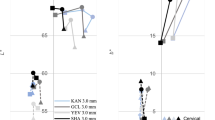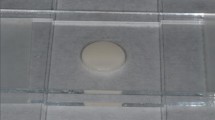Abstract
To evaluate the stain susceptibility of CAD/CAM blocks and direct composite after long term exposure to various staining agents. 40 disk-shaped samples were fabricated from each of nine materials; six CAD/CAM (Vitablocs Mark II, Paradigm MZ100, Experimental Vita Hybrid Ceramic, Vita Enamic, Experimental Kerr and Lava Ultimate) and three direct composites (Filtek Supreme, Venus Diamond and Filtek Silorane). Samples were randomly divided into five groups (n = 8) according to different staining solutions (distilled water, tea, red wine, coffee and artificial saliva). Initial L*a*b* values were assessed using a calibrated digital spectrophotometer. Specimens were immersed in staining solutions and stored in an incubator at 37 °C for 120 days. L*a*b* values were assessed again and color change (∆E) was calculated as difference between recorded L*a*b* values. ANOVA, and Duncan test were used to identify differences between groups (α = 0.05). Significant differences in ∆E values were detected between materials (p = 0.000). Among all staining solutions, the highest ∆E value was observed with red wine. The new CAD/CAM blocks (Vita Enamic, Vita Hybrid Ceramic and Lava Ultimate) showed the highest resistance to staining compared to the MZ100 composite resin blocks. Filtek Silorane, a direct composite, showed high stain resistance values compared to CAD/CAM materials and other direct composites. Ceramic and composite CAD/CAM blocks had lower staining susceptibility than methacrylate based direct composite. Staining susceptibility of the new resin based CAD/CAM materials Vita Enamic and Lava Ultimate was comparable to feldspathic ceramic blocks (Vitablocs Mark II). Filtek Silorane showed promising results that were comparable to some CAD/CAM blocks.



Similar content being viewed by others
References
Samra A, Pereira S, Delgado L, Borges C. Color stability evaluation of aesthetic restorative materials. Braz Oral Res. 2008;22:205–10.
Fontes ST, Fernandez MR, De Moura CM, Meireles SS. Color stability of a nanofill composite: effect of different immersion media. J App Oral Sci. 2009;17:388–91.
Micali B, Basting RT. Effectiveness of composite resin polymerization using light-emitting diodes (LEDs) or halogen-based light-curing units. Braz Oral Res. 2004;8:266–70.
Um CM, Ruyter IE. Staining of resin-based veneering materials with coffee and tea. Quintessence Inter. 1991;22:377–86.
Topcu FT, Sahinkesen G, Yamanel K, Erdemir U, Oktay EA, Ersahan S. Influence of different drinks on the colour stability of dental resin composites. Eur J Dent. 2009;3:50–6.
Guler AU, Yilmaz F, Kulunk T, Guler E, Kurt S. Effects of different drinks on stainability of resin composite provisional restorative materials. J Prosth Dent. 2005;94:118–24.
Patel SB, Gordan VV, Barrett AA, Shen C. The effect of surface finishing and storage solutions on the color stability of resin-based composites. J Am Dent Assoc. 2004;135:587–94.
Sham AS, Chu FC, Chai J, Chow TW. Color stability of provisional prosthodontic materials. J Prosth Dent. 2004;91:447–52.
Asmussen E. Factors affecting the color stability of restorative resins. Acta Odonto Scand. 1983;41:11–8.
Uchida H, Vaidyanathan J, Viswanadhan T, Vaidyanathan TK. Color stability of dental composite as a function of shade. J Prosth Dent. 1998;79:372–7.
Dietschi D, Campanile G, Holz J, Meyer JM. Comparison of the color stability of ten new-generation composites: an in vitro study. Dent Mater. 1994;10:353–62.
Van Lauduyt KL, Snauwaert J, De Munck J, Peumans M, Yoshida Y, Poitevin A, Coutinho E, Suzuki K, Lambrechts P, Van Meerbeek B. Systematic review of the chemical composition of contemporary dental adhesives. Biomaterials. 2007;28:3757–85.
Hosoya Y. Five-year color changes of light-cured resin composites: influence of light-curing times. Dent Mater. 1999;15:268–74.
Bagheri R, Burrow MF, Tyas M. Influence of food- simulating solutions and surface finish on susceptibility to staining of aesthetic restorative materials. J Dent. 2005;33:389–98.
Ilie N, Hickel R. Resin composite restorative materials. Aust Dent J. 2011;56:59–66.
Barutcigil C, Yildiz M. Intrinsic and extrinsic discoloration of dimethacrylate and silorane based composites. J Dent. 2012;40:57–63.
Arocha MA, Mayoral JR, Lefever D, Mercade M, Basilio J, Roig M. Color stability of siloranes versus methacrylate-based composites after immersion in staining solutions. Clin Oral Investig. 2013;17:1481–7.
Stawarczyk B, Sener B, Trottmann A, Roos M, Özcan M, Hämmerle C. Discoloration of manually fabricated resins and industrially fabricated CAD/CAM blocks versus glass-ceramic: effect of storage media, duration, and subsequent polishing. Dent Mater J. 2012;31:377–83.
Krejci I, Lutz F, Reimer M. Wear of CAD/CAM ceramic inlays: restorations, opposing cusps, and luting cements. Quintessence Inter. 1994;25:199–207.
Rusin RP. Properties and applications of a new composite block for CAD/CAM. Compend Contin Educ Dent. 2001;22:35–41.
Fasbinder DJ, Dennison JB, Heys DR, Lampe K. The clinical performance of CAD/CAM-generated composite inlays. J Am Dent Assoc. 2005;136:1714–23.
Ruse ND, Sadoun MJ. Resin-composite Blocks for dental CAD/CAM application. J Dent Res. 2014;93:1232–4.
Ferracane JL, Berge HX, Condon JR. In vitro aging of dental composites in water-effect of degree of conversion, filler volume, and filler/matrix coupling. J Biomed Mater Res. 1998;42:465–72.
Lava™ Ultimate CAD/CAM Restorative. Technical product Profile. 2011, 3M ESPE.
Coldea A, Swain MV, Thiel N. Mechanical properties of polymer-infiltrated –ceramic-network materials. Dent Mater. 2013;29:419–26.
Ardu S, Braut V, Gutemberg D, Krejci I, Dietschi D, Feilzer AJ. A long-term laboratory test on staining susceptibility of esthetic composite resin materials. Quintessence Inter. 2010;41:695–702.
Wyszechi G, Stiles WS. Color science: concepts and methods, quantitative data and formulas. 2nd ed. New York: Wiley; 1982. p. 13–116.
Villalta P, Lu H, Okte Z, Garcia-Godoy F, Powers JM. Effects of staining and bleaching on color change of dental composite resins. J Prosth Dent. 2006;95:137–42.
Paul S, Peter A, Pietrobon N, Hammerle CH. Visual and spectrophotometric shade analysis of human teeth. J Dent Res. 2002;81:578–82.
Technical Report: CIE. Improvement to industrial color difference equation. Vienna, Austria: CIE Central Bureau; 2001 (CIE Publication. No. 142).
Lee YK. Comparison of CIELAB DeltaE and CIEDE2000 color-differences after polymerization and thermocycling of resin composites. Dent Mater. 2005;21:678–82.
Arocha MA, Basilio J, Llopis J, Di Bella E, Roig M, Ardu S, Mayoral JR. Colour stainability of indirect CAD–CAM processed composites vs. conventionally laboratory processed composites after immersion in staining solutions. J Dent. 2014;42:831–8.
Kuenhi RC, Marcus RT. An experiment in visual scaling of small color differences. Color Res App. 1979;4:83–91.
Hunter RS. The measurement of appearance. New York: Wiley; 1975. pp. 77–80, 151–152, 225, 334.
Ardu S, Braut V, Di Bella E, Lefever D. Influence of background on natural tooth colour coordinates: an in vivo evaluation. Odontology. 2014;102:267–71.
Ertas E, Güler AU, Yücel AC, Köprül H, Güler E. Color stability of resin composites after immersion in different drinks. Dent Mater. 2006;25:371–6.
Stober T, Gilde H, Lenz P. Color stability of highly filled composite resin materials for facings. Dent Mater. 2001;17:87–94.
Acar O, Yilmaz B, Altintas SH, Chandrasekaran I, Johnston WM. Color stainability of CAD/CAM and nanocomposite resin materials. J Prosthet Dent. 2015 (in press).
Lawson NC, Burgess JO. Gloss and stain resistance of ceramic-polymer CAD/CAM restorative blocks. J Esthet Restor Dent. 2015 (in press).
Pearson GJ, Longman CM. Water sorption and solubility of resin-based materials following inadequate polymerization by a visible-light curing system. J Oral Rehabil. 1989;16:57–61.
Acknowledgments
The authors would like to thank 3M/ESPE, Vita Zahnfabrik AG, Heraeus Kulzer and Kerr Corporation, for their support with the materials used in this study. The post of the principle investigator was fully funded by the Saudi Ministry of Higher Education.
Author information
Authors and Affiliations
Corresponding author
Ethics declarations
Conflict of interest
The authors declare that they have no conflict of interest.
Rights and permissions
About this article
Cite this article
Alharbi, A., Ardu, S., Bortolotto, T. et al. Stain susceptibility of composite and ceramic CAD/CAM blocks versus direct resin composites with different resinous matrices. Odontology 105, 162–169 (2017). https://doi.org/10.1007/s10266-016-0258-1
Received:
Accepted:
Published:
Issue Date:
DOI: https://doi.org/10.1007/s10266-016-0258-1




